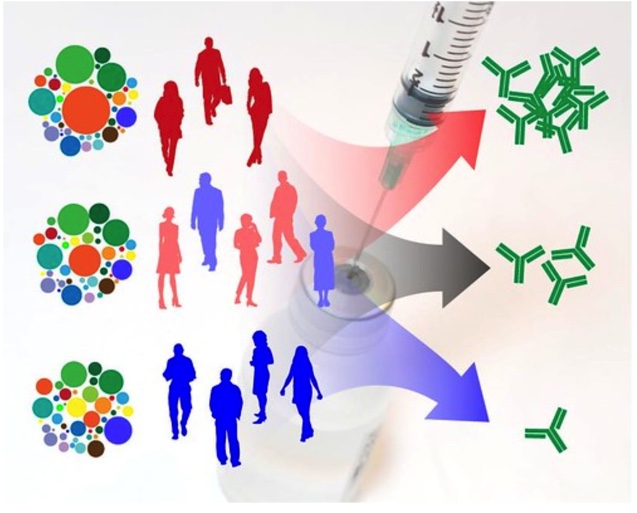RNA, DNA, when will this vaccine come our way?
Photo used with permission by Google Commons.
A scientist-created model shows how differing cell populations (left) could affect how many antibodies are made (right). Red indicates people responding well to a vaccine, while blue indicates people responding less favorably.
Every fall or at your annual checkup, you likely get poked with a needle containing a vaccine that can protect you from diseases that could otherwise take over your body. However, vaccines are more biologically complex than you may realize. With information going around about a possible vaccine for the coronavirus, students have differing opinions about the safety and timing of it.
Freshman Jax (Jacob) Felman is hesitant to believe that a vaccine could be available to the public within the next few months, but would be willing to receive the vaccine when it becomes available. “Even though I despise needles, I get the flu shot every year and I would be willing to get the Covid vaccine too,” Felman said.
Junior Eva Yeghyan believes that the vaccine could be released, at the latest, in six months. When released, Yeghyan is willing to receive this vaccine because of its credibility, but believes that there will be people who refuse to take it. “I have heard that it’s pretty controversial and still a work in progress due to some side effects,” Yeghyan said.
In order to create any vaccine, months or even years of testing go on behind the scenes in scientific labs to ensure that the vaccine is both safe and effective. In order for your immune system to mount a response to a vaccine, part of a deactivated virus itself is injected. This amount of virus must be inactive and extremely small in order to reduce the risk of infections.
In the case of COVID-19, the vaccine candidates are RNA or DNA. “A vaccine is made from a virus or part of a virus in order to expose your immune system to the virus so that your immune system learns how to mount a response against this invader. Usually this is done with a heat-killed virus or portion of a virus, which means the virus is no longer able to infect you, but your body can still see it and learn how to recognize it early on if you were to be exposed to the live virus.
Sometimes vaccines are made with live virus or attenuated virus, which means it has been modified so it is less infectious,” chemistry teacher Dr. Rebecca Firoved said.
It is also important to recognize that the testing of a virus must be done on humans to measure efficacy and adverse side effects. Because everyone will react differently to vaccines, no vaccine will be 100% effective or without side effects.
However, vaccines are tested in a controlled and clinical setting with testing in phases to avoid rare side effects and to reach maximum efficacy. “It is also worth noting that previous reports of vaccines being linked to Autism have been disproven by scientific studies carried out by scientists across the word, so that is not a risk factor that should be considered,” Firoved said.
Companies such as Pfitzer have recently released information that their vaccine is 95% effective. While information about when this vaccine could be released is unknown at this time, it is known that low percentages of people had side effects from this vaccine.
Your donation will support the student journalists of Thomas S. Wootton High School. Your contribution will allow us to purchase equipment and cover our annual website hosting costs.
Dylan is a 2023 graduate.










